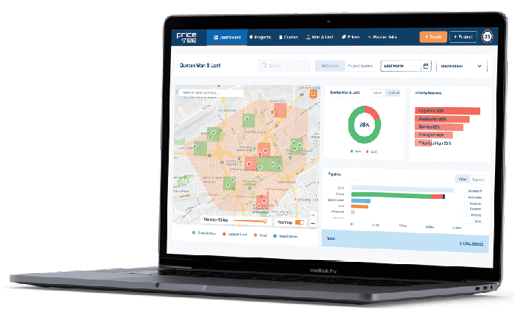EveryPoint Discusses The Business Cases Around Effective Inventory Management And Optimized Pricing In Aggregates.
By Barry Hudson and Lisa Tener

Each day hundreds of aggregate teams collaborate to ensure the successful production, distribution, sale and delivery of bulk products to customers in the United States and abroad. Inaccurate perpetual inventory data leads to poor decisions and labor-intensive corrective measures which inflate expenses, increase business risk, and lose revenue.
Pricing opportunities also are often missed because accurate inventory or ineffective forecasts are not readily available to the sales department. Establishing accuracy and trust in perpetual inventory should be the first step taken to improve and streamline supply chain and logistics decisions, driving expanded profitability.
The economic gains from curing gaps in data is what we call “big rock math.” Lack of access to real-time data in the bulk materials industry is an issue that creates chronic dysfunction in how operations decisions are made and leads to a tangible drain on profitability. Guesswork and manual tracking are so incumbent as the standard operating practice that a lean mindset is a pipedream.
Perpetual inventory is defined as “systems of inventory where information on quantity is updated on a continuous basis as a function of doing business.” A physical inventory count is performed to identify and address any error that builds up in the perpetual inventory.
Errors in perpetual inventory in the aggregates industry often result from significant variances in inputs (i.e., deliveries, production, product movements) and outputs (i.e., sales, transfers, loss). These variances are often the result of the accuracy and precision of measurement techniques utilized (draft weights, truck counts, scales, estimates), inaccurate density or conversion factors, and timing and accuracy of data entry.

Several studies at RMX, distribution and production yards throughout aggregates business operations prove that frequent access to accurate inventory data will reduce the cost and labor of managing inventory and increase supply chain efficiencies across organizations, in addition to expanding the return on working capital. Big gains are available due the scale of big rock operations.
In one study at rail, barge and ship distribution yards of a major aggregates producer, existing perpetual inventory tools were found to have varying errors at all sites across multiple material types, with errors ranging up to 40%. This chronic pattern of errors diluted trust in the perpetual inventory reports.
Due to the low level of confidence in existing tools, employees in these logistics centers wasted time maintaining separate spreadsheets and handwritten notes to support day-to-day decision making. The systemic issues with inaccurate data resulted in less-than-optimal decisions.
A few insights:
- Inefficient Sales Efforts: Sales teams spend hours confirming inventory reports through visual pile inspection and manual measurements such as walking the piles. This is time that could be spent selling to and interacting with customers.– Big rock math insight: For a domestic producer with an output of 200 million tpy, even a 10% improvement yields margin gain on 20 milllion tons. At $5 a ton, that is a $100 million profit gain opportunity.
– Why wouldn’t you take your inventory data and statuses and have them interfaced with a Pricing and Quotation engine like Price-Bee.com and allow pricing decisions based on your current or forecasted inventory? - Materials Shortages: Material is sold that does not actually exist due to inventory reporting errors. To fulfill these commitments, rock must be shipped from other nearby sites or purchased from competitors, reducing margins due to additional costs of transportation and procurement. Alternatively, sales are also lost due to errors in perpetual inventory showing less on hand inventory than what is on the ground.– Big rock math insight: Most domestic producers are running below capacity, which contributes to the lack of urgency around materials shortages. A domestic producer with 400 sites yielding 200 million tons a year has idle capacity nearly matching its output, not to mention rock in the ground.
- Operational Productivity Drain: Site managers and their operations teams spend hours each week performing separate inventory counts and verifications due to a lack of trust in the accuracy of the perpetual inventory records to support quality decisions.– Big rock math insight: Even a 10-cent improvement on 200 million tons equates to $20 million. How easy is it? In this logistic center study, reducing labor waste by just eliminating weekly calls and daily inventory checks, manual racking is an astounding 150,000+ hours, or 75FTE, more than $3 million cost efficiency gain.
- Excess Materials Inventory: Sites store excess material beyond what is needed in reserve due to the Fear of Running Out (FORO). One site was observed to have more than six weeks of inventory on hand for some materials and could realistically cut this number down by more than 60%.– Big rock math insight: Let’s say you have inventory stock of $100 million. Who wouldn’t want to close the gap on FORO for $60 million free working capital?
In addition to concrete gaps in asset utilization and observable profitability drains, other data potholes include phantom quantities recorded to account for shipping and receiving errors, and massive adjustments to reconcile the books once the yards empty out. A dearth of real-time data makes it impossible to understand whether a rock operation is winning or losing in today’s competitive market.
With consistent, reliable inventory data, better decisions will be made. Additionally, operating efficiencies in material distribution will increase capacity to capture a greater market share and deliver more product to customers, a big rock win.


Barry Hudson is co-founder of Price-Bee.com and Lisa Tener is CFO/COO of EveryPoint.
EveryPoint is an intelligent software service that continuously replicates real-world assets and environments, creating valuable understanding accessible from any angle. SR Measure is the fastest way to measure a stockpile. Track real-time mulch and soil inventory by just walking around the pile with your iPhone to get a measurement.
Stockpile Reports’ proprietary algorithms convert images of stockpiles into accurate measurements with speed and precision using an iPhone or drone. Price-Bee.com is the leading CPQ (Configure, Price, Quote) system designed specifically for Construction Materials, and is the cornerstone system for achieving between 4 and 8% additional revenue through controlled processes.
